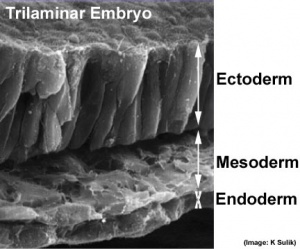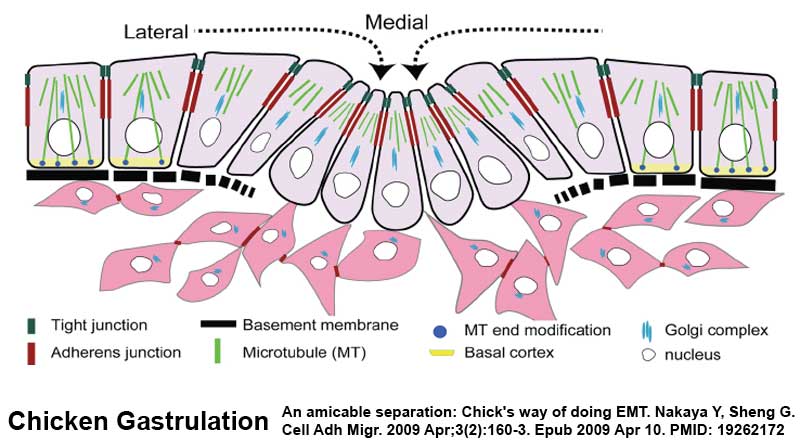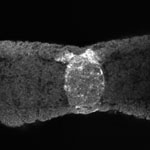Mesoderm
| Embryology - 26 Apr 2024 |
|---|
| Google Translate - select your language from the list shown below (this will open a new external page) |
|
العربية | català | 中文 | 中國傳統的 | français | Deutsche | עִברִית | हिंदी | bahasa Indonesia | italiano | 日本語 | 한국어 | မြန်မာ | Pilipino | Polskie | português | ਪੰਜਾਬੀ ਦੇ | Română | русский | Español | Swahili | Svensk | ไทย | Türkçe | اردو | ייִדיש | Tiếng Việt These external translations are automated and may not be accurate. (More? About Translations) |
Introduction
The middle layer of the early trilaminar embryo germ layers (ectoderm, mesoderm and endoderm) formed by gastrulation.
This middle germ layer forms connective tissues and muscle throughout the body, with the exception of in the head region where some of these structures have a neural crest (ectoderm) origin.
- connective tissues - cartilage, bone, blood, blood vessel endothelium, dermis, etc.
- muscle - cardiac, skeletal, smooth.
Students often mix-up the terms mesoderm (middle layer) with mesenchyme (embryonic connective tissue). It is true that mesoderm initially does have a mesenchymal cellular organisation, but can also form a range of epithelial structures (surrounding somites, mesothelium lining of body cavities).
- Mesoderm Links: Endoderm | Mesoderm | Ectoderm | Lecture - Mesoderm Development | Lecture - Musculoskeletal Development | Notochord | Development Animation - Notochord | Somitogenesis | Musculoskeletal | Sonic hedgehog | Category:Mesoderm
Some Recent Findings
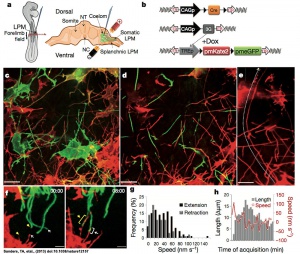
|
| More recent papers |
|---|
|
This table allows an automated computer search of the external PubMed database using the listed "Search term" text link.
More? References | Discussion Page | Journal Searches | 2019 References | 2020 References Search term: Mesoderm Development <pubmed limit=5>Mesoderm Development</pubmed> |
Mesoderm Formation during Gastrulation
| <mediaplayer width='390' height='500' image="http://php.med.unsw.edu.au/embryology/images/b/b9/Mesoderm_001_icon.jpg">File:Mesoderm_001.mp4</mediaplayer> | This animation shows the migration of mesoderm throughout the embryonic disc during gastrulation.
The pink arrows show how mesodermal cells spread out between the ectoderm and endoderm layers, forming the third layer of the trilaminar embryo. Axial process - the arrow running from the primitive node upward is the axial process which will later form the notochord. There are only 2 regions where mesoderm is not found: buccopharyngeal membrane and cloacal membrane.
Prechordal plate - lies above the buccopharyngeal membrane and is the cardiogenic mesoderm, that will form the heart. |
- Links: Gastrulation
Patterning
200px[ 200px[[[:File:Mesoderm-cartoon3.jpgf|200px]][ 200px
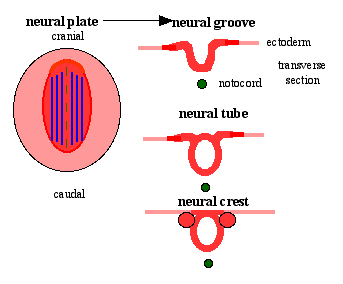
|
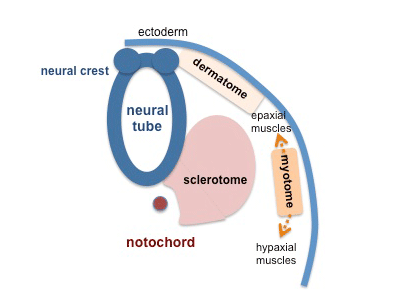
|
| Neural tube patterning | Somite patterning |
Molecular Factors
References
- ↑ Timothy A. Sanders, Esther Llagostera, Maria Barna. Specialized filopodia direct long-range transport of SHH during vertebrate tissue patterning. Nature Apr 28, 2013.
- ↑ <pubmed>23533180</pubmed>
- ↑ <pubmed>20182616</pubmed>
- ↑ <pubmed>20497604</pubmed>
Reviews
<pubmed>20568241</pubmed>
<pubmed>17705304</pubmed>
Articles
<pubmed>21159819</pubmed> <pubmed>20565707</pubmed> <pubmed>7956820</pubmed>
Historic
<pubmed>17104422</pubmed>
Search PubMed
Search NLM Online Textbooks: "Mesoderm" : Developmental Biology | The Cell- A molecular Approach | Molecular Biology of the Cell | Endocrinology
Search Pubmed: Mesoderm | Notochord
External Links
External Links Notice - The dynamic nature of the internet may mean that some of these listed links may no longer function. If the link no longer works search the web with the link text or name. Links to any external commercial sites are provided for information purposes only and should never be considered an endorsement. UNSW Embryology is provided as an educational resource with no clinical information or commercial affiliation.
Take the Quiz
Glossary Links
- Glossary: A | B | C | D | E | F | G | H | I | J | K | L | M | N | O | P | Q | R | S | T | U | V | W | X | Y | Z | Numbers | Symbols | Term Link
Cite this page: Hill, M.A. (2024, April 26) Embryology Mesoderm. Retrieved from https://embryology.med.unsw.edu.au/embryology/index.php/Mesoderm
- © Dr Mark Hill 2024, UNSW Embryology ISBN: 978 0 7334 2609 4 - UNSW CRICOS Provider Code No. 00098G
